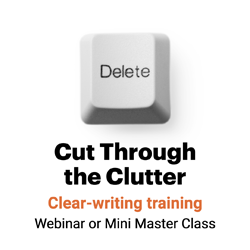Hint: Cutting copy is not the solution
It’s the communicator’s biggest problem: How do you get audience members to pay attention to, understand and remember your messages when they’re burdened with so much information?

Your readers receive the data equivalent of 174 newspapers, ads included, daily. With this much information every day, how do you cut through the clutter of competing messages?
The problem with information overload, as Bertram Gross taught us, is that your readers’ processing capacity goes down as the amount of information goes up. When people struggle to manage information, not only are they unable to find the most important information — they also forget where they parked their cars.
How can you overcome information overload to get the word out in your blog posts, social media, internal communications and more? Try these techniques to deal with information overload:
6 paradoxes for breaking through the clutter
What do you do when information overload occurs? Martin J. Eppler and Jeanne Mengis recommend these six “paradoxes” for presenting information that breaks through the clutter:
- Familiar surprise. Grab audience members’ attention in an intriguing, yet accessible, way. You might try an interesting subject line, a clever lead or an unusual graphic.
- Detailed overview. Before diving into the details, let your audience members know what they’ll learn from this piece. You might provide context and an overview in a summary after the headline.
- Flexible stability. Don’t make audience members learn new formats and structures to get your information. Standardized website and memo formats and information mapping help audience members find what they’re looking for faster.
- Simple complexity. Just shaving more words off your message doesn’t solve information overload. You also need to make the information more understandable. Visual and verbal metaphors clarify complex concepts; they help audience members understand new information by linking it to familiar ideas.
- Concise redundancy. Deliver information in multiple formats to reach different information consumers. You might present information through statistics, analogies and examples in an article, for instance, or visually and verbally in a meeting.
- Unfinished completeness. Get audience members involved in the message with comments, polls and questions at the ends of articles. When audience members participate in a message rather than just consuming it, they understand it better and remember it longer.
Find Eppler and Mengis’s work in “Preparing Messages for Information Overload Environments.” That’s a report of the International Association of Business Communicators’ Research Foundation.
Note that cutting word count does not make this list.
Surprise gets attention.
Why is surprise so effective at overcoming information overload in communication?
Our brains are designed to notice changes so we can react to danger.
“Surprise jolts us to attention,” write Chip Heath and Dan Heath in Made to Stick: Why Some Ideas Survive and Others Die. “Surprise is triggered when our schemas fail, and it prepares us to understand why the failure occurred. When our guessing machines fail, surprise grabs our attention so that we can repair them for the future.”
How do you create a surprising message? Chip and Dan Heath offer this three-step process:
- Start with your key message.
- Figure out what’s counterintuitive about that message. What are the unexpected implications?
- Craft your message to focus on this “uncommon sense.”
To make surprise effective, make it “postdictable” — i.e., predictable after the fact. Think “Sixth Sense,” not “Black Swan.”
How to? Make sure your surprise is key to your core message. Communicate, don’t decorate.
Surprise gets attention. Curiosity keeps attention.
Increase your return on information.
In 1989, systems scientist Russell Ackoff created a hierarchy of information, from least valuable to most:
- Data
- Information
- Knowledge
- Understanding
- Wisdom
Despite this, most organizations still invest the bulk of their resources on gathering and moving data, the least on wisdom.
That’s expensive. It wastes time.
Is your copy just adding to the pile of facts — data — in your organization? Or is your piece of information likely to help your audience members find knowledge and understanding?
To increase your rate of return on information, consider Ackoff’s hierarchy before you press Send. Is your copy just adding to the pile of facts — data — in your organization? Or is your message likely to help your audience members find knowledge and understanding?
As this data deluge threatens to engulf your workplace, your company needs communicators who add value to information. They need people who translate instead of regurgitate, who inform instead of disseminate.
Do that, and you can serve as an organizational alchemist who transforms a flood of facts into a stream of knowledge. Wisdom, even.
And that’s the gold standard of the Information Age.
‘Be a complexity reducer, not an information producer’
Diane Gayeski, Ph.D., once found that a restaurant chain gave managers four to six hours’ worth of information to process each day. (That, alas, is not Gayeski’s most startling statistic, just the handiest.)
Gayeski, CEO of Gayeski Analytics, helps companies figure out how much time they’re asking employees to spend processing information.
After watching her clients’ employees deal with a huge amount of information, Gayeski came up with this rule of thumb for communicating:
“Be a complexity reducer, not an information producer.”
That would make a great job description for communicators.
Which role are you playing for your audience?
How can you make sure you’re cutting through the clutter, instead of contributing to it? One approach is to do less, but do it better.
This suggestion flies in the face of current communications cultures. There, writers and editors are expected to produce a website, weekly newsletters, daily updates and hourly news flashes for each audience they serve. (Test: When you check your inbox, how do you feel about getting yet another corporate message?)
Don’t get sucked into the system. Remember, nobody wants more information. (According to the Pew Research Center, they especially dislike corporate communications.) They just want better information.
One solution? Perform triage on your work:
- Prioritize your efforts around business objectives. That’s a quick way to filter relevant information from irrelevant information.
- Spend the most time on top-priority items. That will help you with day-to-day project management as well as information overload in the workplace.
- Do a moderate job on mid-priority tasks.
- Hack out low-priority projects. Can you get by with five Ws and an H?
Even better: Decline low-priority projects that don’t further business objectives. (The best communicators have created a culture where they can do so. One’s even created management software to help.)
The alternative? In addition to contributing to information overload, you’ll condemn yourself to a career of mediocrity.
____
Sources: “The Too-Much Information Age,” Seed Magazine, January/February 2008
Chip Heath and Dan Heath, Made to Stick: Why Some Ideas Survive and Others Die, Random House, 2007
Managing of organizations

Leave a Reply